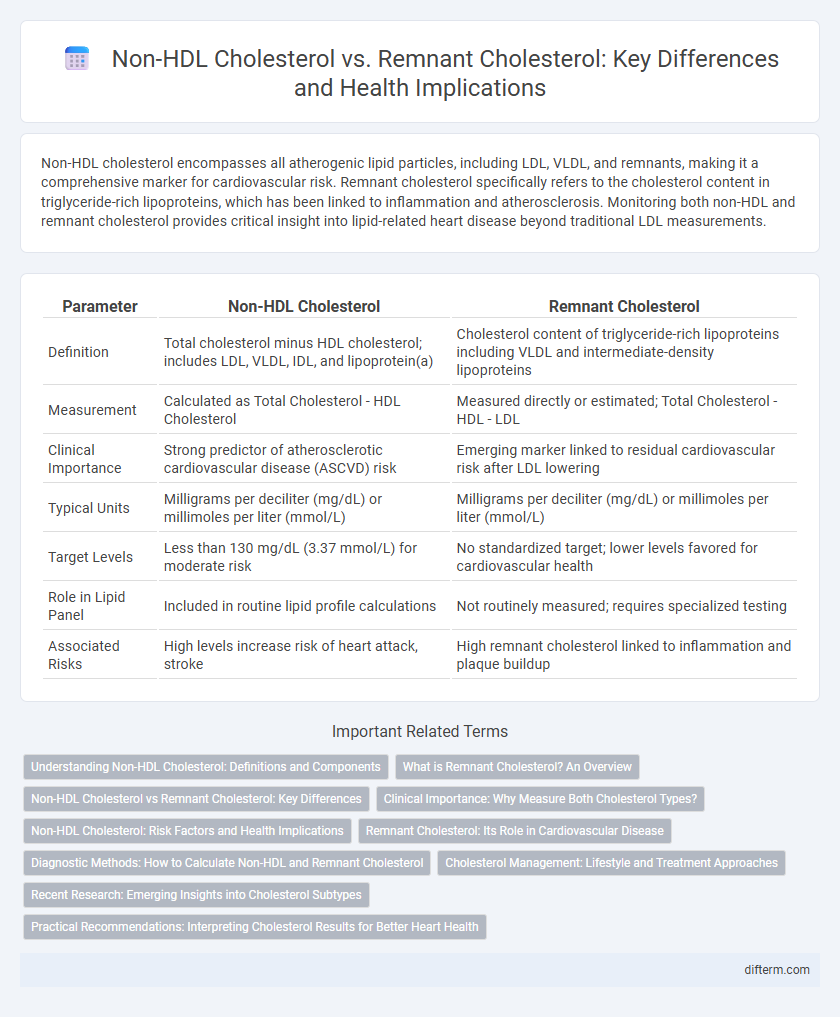Non-HDL cholesterol encompasses all atherogenic lipid particles, including LDL, VLDL, and remnants, making it a comprehensive marker for cardiovascular risk. Remnant cholesterol specifically refers to the cholesterol content in triglyceride-rich lipoproteins, which has been linked to inflammation and atherosclerosis. Monitoring both non-HDL and remnant cholesterol provides critical insight into lipid-related heart disease beyond traditional LDL measurements.
Table of Comparison
| Parameter | Non-HDL Cholesterol | Remnant Cholesterol |
|---|---|---|
| Definition | Total cholesterol minus HDL cholesterol; includes LDL, VLDL, IDL, and lipoprotein(a) | Cholesterol content of triglyceride-rich lipoproteins including VLDL and intermediate-density lipoproteins |
| Measurement | Calculated as Total Cholesterol - HDL Cholesterol | Measured directly or estimated; Total Cholesterol - HDL - LDL |
| Clinical Importance | Strong predictor of atherosclerotic cardiovascular disease (ASCVD) risk | Emerging marker linked to residual cardiovascular risk after LDL lowering |
| Typical Units | Milligrams per deciliter (mg/dL) or millimoles per liter (mmol/L) | Milligrams per deciliter (mg/dL) or millimoles per liter (mmol/L) |
| Target Levels | Less than 130 mg/dL (3.37 mmol/L) for moderate risk | No standardized target; lower levels favored for cardiovascular health |
| Role in Lipid Panel | Included in routine lipid profile calculations | Not routinely measured; requires specialized testing |
| Associated Risks | High levels increase risk of heart attack, stroke | High remnant cholesterol linked to inflammation and plaque buildup |
Understanding Non-HDL Cholesterol: Definitions and Components
Non-HDL cholesterol encompasses all atherogenic lipoproteins, including LDL, VLDL, IDL, and lipoprotein(a), representing total cholesterol minus HDL cholesterol. Unlike remnant cholesterol, which specifically refers to cholesterol in triglyceride-rich lipoproteins like VLDL and intermediate-density lipoproteins, non-HDL cholesterol offers a broader marker for cardiovascular risk assessment. Measuring non-HDL cholesterol provides a more comprehensive evaluation of atherogenic particles compared to LDL cholesterol alone, improving prediction of heart disease risk.
What is Remnant Cholesterol? An Overview
Remnant cholesterol refers to the cholesterol content found in triglyceride-rich lipoproteins, such as very low-density lipoproteins (VLDL) and intermediate-density lipoproteins (IDL), which are remnants of the metabolism of these particles. It plays a significant role in atherogenesis, as remnant cholesterol particles can penetrate arterial walls, leading to inflammation and the buildup of plaques that increase cardiovascular risk. Unlike non-HDL cholesterol, which encompasses all atherogenic lipoproteins, remnant cholesterol specifically targets the cholesterol contained in triglyceride-rich lipoproteins, making it a critical marker for residual cardiovascular risk.
Non-HDL Cholesterol vs Remnant Cholesterol: Key Differences
Non-HDL cholesterol measures all atherogenic lipoproteins, including LDL, VLDL, IDL, and lipoprotein(a), providing a comprehensive risk indicator for cardiovascular disease. Remnant cholesterol specifically refers to cholesterol contained in triglyceride-rich lipoproteins such as VLDL and intermediate-density lipoproteins, which contribute to atherosclerosis when elevated. The primary difference lies in spectrum, with non-HDL cholesterol encompassing all non-HDL particles, while remnant cholesterol isolates only the remnants of triglyceride-rich lipoproteins.
Clinical Importance: Why Measure Both Cholesterol Types?
Measuring both non-HDL cholesterol and remnant cholesterol provides a comprehensive assessment of cardiovascular risk by capturing distinct atherogenic lipoprotein particles. Non-HDL cholesterol includes all potentially harmful lipoproteins like LDL, VLDL, and intermediate-density lipoproteins, offering a broader risk profile beyond LDL alone. Remnant cholesterol specifically reflects triglyceride-rich lipoproteins linked to inflammation and plaque formation, highlighting residual risk even when LDL levels are controlled.
Non-HDL Cholesterol: Risk Factors and Health Implications
Non-HDL cholesterol, which includes all atherogenic lipoproteins such as LDL, VLDL, and lipoprotein(a), serves as a critical indicator for cardiovascular risk assessment beyond traditional LDL measurements. Elevated non-HDL cholesterol levels correlate strongly with the development of atherosclerosis, increasing the likelihood of coronary artery disease, stroke, and peripheral artery disease. Monitoring non-HDL cholesterol provides a comprehensive evaluation of dyslipidemia and guides more effective lipid-lowering therapy to reduce cardiovascular morbidity and mortality.
Remnant Cholesterol: Its Role in Cardiovascular Disease
Remnant cholesterol, the cholesterol content of triglyceride-rich lipoproteins, plays a significant role in cardiovascular disease by contributing to atherosclerotic plaque formation and inflammation. Unlike non-HDL cholesterol, which includes all atherogenic particles, remnant cholesterol specifically targets remnants of very-low-density and intermediate-density lipoproteins that persist in circulation after triglyceride metabolism. Elevated remnant cholesterol levels are independently associated with increased risk of coronary artery disease, making it a crucial target for therapeutic intervention beyond traditional LDL cholesterol management.
Diagnostic Methods: How to Calculate Non-HDL and Remnant Cholesterol
Non-HDL cholesterol is calculated by subtracting high-density lipoprotein (HDL) cholesterol from total cholesterol, providing a comprehensive measure of all atherogenic lipoproteins. Remnant cholesterol is derived by subtracting the sum of HDL and low-density lipoprotein (LDL) cholesterol from total cholesterol, quantifying triglyceride-rich lipoprotein remnants. Both calculations are essential for assessing cardiovascular risk using standard lipid panel results without requiring direct measurement methods.
Cholesterol Management: Lifestyle and Treatment Approaches
Non-HDL cholesterol encompasses all atherogenic lipoproteins, making it a critical target in cholesterol management to reduce cardiovascular risk. Remnant cholesterol, found in triglyceride-rich lipoproteins, contributes to atherosclerosis and requires focused interventions such as dietary modifications to reduce saturated fats and increase physical activity. Pharmacologic treatments, including statins and fibrates, effectively lower both non-HDL and remnant cholesterol levels, improving lipid profiles and cardiovascular outcomes.
Recent Research: Emerging Insights into Cholesterol Subtypes
Recent research highlights the distinct roles of non-HDL cholesterol and remnant cholesterol in cardiovascular risk assessment, emphasizing that remnant cholesterol comprises triglyceride-rich lipoproteins contributing uniquely to atherogenesis. Studies indicate that elevated remnant cholesterol levels correlate strongly with inflammation and endothelial dysfunction, independent of traditional LDL cholesterol metrics. These findings underscore the need for targeted therapeutic strategies addressing remnant cholesterol to better prevent and manage cardiovascular diseases.
Practical Recommendations: Interpreting Cholesterol Results for Better Heart Health
Non-HDL cholesterol includes all atherogenic lipoproteins, making it a comprehensive marker for cardiovascular risk assessment beyond LDL cholesterol alone. Remnant cholesterol specifically measures triglyceride-rich lipoproteins, providing additional insight into residual cardiovascular risk, especially in patients with metabolic syndrome or diabetes. Clinicians should interpret both non-HDL and remnant cholesterol values to tailor lipid-lowering therapies, aiming for target levels that reduce the risk of atherosclerotic cardiovascular disease and improve long-term heart health outcomes.
Non-HDL Cholesterol vs Remnant Cholesterol Infographic

 difterm.com
difterm.com